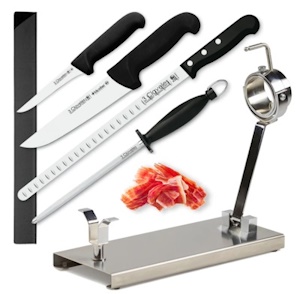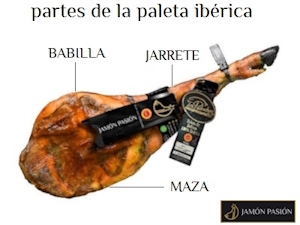Discover the art of slicing an Iberian shoulder in the comfort of your own home. Follow our tips to achieve thin, delicious slices that highlight the exquisiteness of this gastronomic treasure, a pleasure that you can enjoy with skill with just a little practice!
The Iberian shoulder has a different morphology to that of Iberian ham and it can be a little more complicated to make the most of all the meat if you are not experienced, but we are going to make it very easy for you to enjoy the task.
Utensils needed to cut an iberico ham shoulder
To cut an Iberian shoulder ham safely, you need some specific utensils:
Ham Knife: This is a long, thin knife specially designed for slicing Iberian ham and shoulder. It has a flexible blade that allows for thin, uniform cuts.
Kitchen knife: A wide-bladed knife, the most common knife used in the kitchen. It will be useful for initial cleaning, removing the rind and fat.
Boning knife: Small and narrow-bladed, designed to be inserted between the bone and the meat in order to separate it and continue cutting slices.
Ham holder: Also known as a "Jamonero", it is a support that holds the shoulder in place while you slice it. It usually has a stable base and a clamping system to hold the shoulder firmly in place during slicing.
Steel Sharpening: To keep the ham knife sharp and in optimum condition. The sharpening steel is a steel rod that helps to realign the knife's edge, while a sharpener may be necessary from time to time to sharpen it properly.
These utensils will help you to cut the Iberian shoulder with precision, allowing you to enjoy its exceptional flavour and texture to the full.

Iberian Pork shoulder morphology
The front legs of pigs, from which ham shoulders are obtained, have a different morphology to the hind legs, the hams. This part has more angulated bones, so the way of cutting it is slightly different from the cured hams, although its parts are called in the same way:
- Maza: This is the juiciest part of the shoulder due to its greater fat infiltration. It is the part that shows if we place the ham shoulder with the hoof facing upwards.
- Babilla or Contramaza: This is the part opposite to the "maza", that is to say, the part that is shown if we place the shoulder in the ham stand with the hoof facing downwards, and in this area the meat is more cured and with less fat.
- Jarrete or Codillo: This is the narrowest part descending towards the hoof area. In this area the meat is more fibrous and with sweeter nuances. This part is very tasty and can be sliced, but it dries out very quickly if it is not eaten quickly. Slices are usually made from the most cured areas of this part of the Iberian shoulder.

How to cut a shoulder of Iberian ham
The first thing to bear in mind is which side you are going to start cutting the pork shoulder. If it is going to be eaten quickly, within a few days, or within a few hours because you are going to serve it at a celebration, the ideal thing to do is to start cutting the shoulder from the "maza", the juiciest area with the greatest infiltration of fat and therefore the most powerful flavour. This part is the widest and is shown with the hoof facing upwards once placed on the ham stand. If, on the other hand, it is to be consumed slowly, over a period of weeks, it is advisable to start with the "Babilla", the narrowest area with the least fat, and therefore a little drier, so that when you turn it over, the mace will still retain its juiciness.
Keep in mind that you should never clean the whole piece at once, unless you are going to eat it the same day. You should clean as you eat, just 2 or 3 cm below the area you are cutting.
Here is a summary video so you can see how to start and cut the Iberian shoulder.
Tips for carving the pork shoulder at home
Before starting the cutting process on an Iberian shoulder, it is essential to understand that the rind plays a crucial role in the preservation of the meat. Therefore, avoid removing more rind than necessary.
Once the cut is made, discard the rind, as using it to cover the meat is contraindicated. Fat can turn rancid and transfer its unwanted flavour to the meat.
It is essential to pay attention to the thickness of the slices, seeking a balance, allowing the flavours to come off on contact with the palate.
The knife should slide smoothly under the slice, almost parallel. When cutting, keep the direction towards you, but be careful to avoid accidents.
As you go along, use a boning knife to separate the meat around the bone, making it easier to cut slices and optimising the use of the shoulder.
When the bones make it difficult to cut from one side, turn the shoulder over to continue the process.
Preserving a pork shoulder iberico ham
When you buy a iberico pork shoulder, as soon as you get home you should remove all the packaging such as the box, the greaseproof paper wrapped around the shoulder ham and the cotton netting. Hams and shoulders must breathe and it is never a good idea for them to remain wrapped for more than a few days.
Do not use this packaging to protect the meat once it has been consumed, as it will most likely contain fat, and this fat will go rancid and transfer those aromas and flavours to the area it comes into contact with. Always use a clean cloth and food paper to keep the cut area of the ham clean.
It is not a good idea, as many people tend to do, to cover the ham with a slice of bacon left over after the initial cleaning, as this fat will go rancid in just a day or two.
It is very important that you place it in a place in the house where it is not exposed to direct sunlight or near electrical appliances that emit heat.
By following these simple tips, you will have a shoulder ham that will keep well for a long time. Whether it is a Serrano, Iberian or acorn-fed Iberian shoulder.
